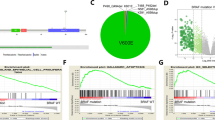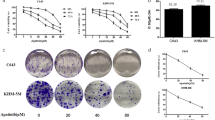Abstract
Purpose
Thyroid carcinoma is the most frequent endocrine malignancy with high occurrence of BRAFV600E mutations. Though targeted therapy by vemurafenib, a specific inhibitor for BRAFV600E, has achieved great advance in therapeutic landscape, resistance occurrence is still a clinical challenge. Here, we sought to elucidate the function of high mobility group box 1 (HMGB1) in vemurafenib resistance in thyroid cancer harboring BRAF mutation.
Methods
The expression of HMGB1 in BRAF-mutant BCPAP and BRAF-wild CAL-62 cells were determined by qRT-PCR and western. Then, BCPAP cells were transfected with recombinant HMGB1 plasmids, and vemurafenib-resistant BCPAP-R cells were treated with si-HMGB1. The efficacy of HMGB1 on vemurafenib resistance was evaluated by detecting cell viability, apoptosis, and caspase-3 activity. In addition, the involvement of autophagy pathway was investigated.
Results
Lower expression of HMGB1 was observed in BRAF-mutant BCPAP cells that had high sensitivity to vemurafenib. Overexpression of HMGB1 attenuated BCPAP cell sensitivity to vemurafenib by increasing cell viability and decreasing cell apoptosis and caspase-3 activity. Intriguingly, higher expression of HMGB1 was confirmed in vemurafenib-resistant BCPAP-R cells. Moreover, knockdown of HMGB1 sensitized BCPAP-R cells to vemurafenib resistance. Mechanistically, vemurafenib exposure induced autophagy by enhancing LC3II, Beclin-1 expression, and reducing autophagy substrate p62 expression. Importantly, targeting HMGB1 suppressed vemurafenib-induced autophagy. Blocking autophagy pathway with its inhibitor 3-MA offset BCPAP-R cell resistance to vemurafenib.
Conclusions
These findings highlight that HMGB1-mediated autophagy may account for vemurafenib resistance in thyroid cancer harboring BRAF mutation, implying a promising approach to overcome vemurafenib resistance in vemurafenib-mutant thyroid carcinomas.





Similar content being viewed by others
Data availability
All data generated or analysed during this study are included in this published article.
References
H. Lim, S.S. Devesa, J.A. Sosa, D. Check, C.M. Kitahara, Trends in thyroid cancer incidence and mortality in the United States, 1974-2013. Jama 317(13), 1338–1348 (2017). https://doi.org/10.1001/jama.2017.2719
H.J. Song, Z.L. Qiu, C.T. Shen, W.J. Wei, Q.Y. Luo, Pulmonary metastases in differentiated thyroid cancer: efficacy of radioiodine therapy and prognostic factors. Eu. J. Endocrinol. 173(3), 399–408 (2015). https://doi.org/10.1530/EJE-15-0296
J. Iva, G. Filip, B. Martin, Z. Pavel, C. Jan, The significance of BRAFV600E mutation in thyroid cancer in terms of novel targeted therapies—overview of current knowledge and studies. Klinicka onkologie: casopis Ceske a Slovenske onkologicke spolecnosti 31(5), 339–344 (2018). https://doi.org/10.14735/amko2018339
M. Xing, BRAF mutation in thyroid cancer. Endocrine-Rel. Cancer 12(2), 245–262 (2005). https://doi.org/10.1677/erc.1.0978
C. Lupi, R. Giannini, C. Ugolini, A. Proietti, P. Berti, M. Minuto, G. Materazzi, R. Elisei, M. Santoro, P. Miccoli, F. Basolo, Association of BRAF V600E mutation with poor clinicopathological outcomes in 500 consecutive cases of papillary thyroid carcinoma. J. Clin. Endocrinol. Metabol. 92(11), 4085–4090 (2007). https://doi.org/10.1210/jc.2007-1179
E. Takacsova, R. Kralik, I. Waczulikova, K. Zavodna, J. Kausitz, A different prognostic value of BRAFV600E mutation positivity in various age groups of patients with papillary thyroid cancer. Neoplasma 64(1), 156–164 (2017). https://doi.org/10.4149/neo_2017_120
P.B. Chapman, C. Robert, J. Larkin, J.B. Haanen, A. Ribas, D. Hogg, O. Hamid, P.A. Ascierto, A. Testori, P.C. Lorigan, R. Dummer, J.A. Sosman, K.T. Flaherty, I. Chang, S. Coleman, I. Caro, A. Hauschild, G.A. McArthur, Vemurafenib in patients with BRAFV600 mutation-positive metastatic melanoma: final overall survival results of the randomized BRIM-3 study. Annals Oncol. 28(10), 2581–2587 (2017). https://doi.org/10.1093/annonc/mdx339
W.J. Wei, Z.K. Sun, C.T. Shen, H.J. Song, X.Y. Zhang, Z.L. Qiu, Q.Y. Luo, Obatoclax and LY3009120 efficiently overcome vemurafenib resistance in differentiated thyroid cancer. Theranostics 7(4), 987–1001 (2017). https://doi.org/10.7150/thno.17322
C. Garbe, T.K. Eigentler, Vemurafenib. Recent results in cancer research. Fortschritte der Krebsforschung. Progres dans les recherches sur le cancer 211, 77–89 (2018). https://doi.org/10.1007/978-3-319-91442-8_6
L. Yang, Y. Yu, R. Kang, M. Yang, M. Xie, Z. Wang, D. Tang, M. Zhao, L. Liu, H. Zhang, L. Cao, Up-regulated autophagy by endogenous high mobility group box-1 promotes chemoresistance in leukemia cells. Leukemia Lymphoma 53(2), 315–322 (2012). https://doi.org/10.3109/10428194.2011.616962
Q. Li, J. Li, T. Wen, W. Zeng, C. Peng, S. Yan, J. Tan, K. Yang, S. Liu, A. Guo, C. Zhang, J. Su, M. Jiang, Z. Liu, H. Zhou, X. Chen, Overexpression of HMGB1 in melanoma predicts patient survival and suppression of HMGB1 induces cell cycle arrest and senescence in association with p21 (Waf1/Cip1) up-regulation via a p53-independent, Sp1-dependent pathway. Oncotarget 5(15), 6387–6403 (2014). https://doi.org/10.18632/oncotarget.2201
M.P. Singh, H.J. Cho, J.T. Kim, K.E. Baek, H.G. Lee, S.C. Kang, Morin hydrate reverses cisplatin resistance by impairing PARP1/HMGB1-dependent autophagy in hepatocellular carcinoma. Cancers 11(7) (2019). https://doi.org/10.3390/cancers11070986
T. Xu, L. Jiang, Z. Wang, The progression of HMGB1-induced autophagy in cancer biology. OncoTargets Therapy 12, 365–377 (2019). https://doi.org/10.2147/OTT.S185876
X. Guan, P. Wang, J. Chi, S. Zhao, F. Wang, Relationships of BRAF mutation and HMGB1 to papillary thyroid carcinoma. Biochem. Biophys. Res. Commun. 486(4), 898–903 (2017). https://doi.org/10.1016/j.bbrc.2017.03.117
W. Wang, H. Kang, Y. Zhao, I. Min, B. Wyrwas, M. Moore, L. Teng, R. Zarnegar, X. Jiang, T.J. Fahey 3rd, Targeting autophagy sensitizes BRAF-mutant thyroid cancer to Vemurafenib. J. Clin. Endocrinol. Metabol. 102(2), 634–643 (2017). https://doi.org/10.1210/jc.2016-1999
E.K. Hanly, R.B. Bednarczyk, N.Y. Tuli, A.L. Moscatello, H.D. Halicka, J. Li, J. Geliebter, Z. Darzynkiewicz, R.K. Tiwari, mTOR inhibitors sensitize thyroid cancer cells to cytotoxic effect of vemurafenib. Oncotarget 6(37), 39702–39713 (2015). https://doi.org/10.18632/oncotarget.4052
D.M. Hyman, I. Puzanov, V. Subbiah, J.E. Faris, I. Chau, J.Y. Blay, J. Wolf, N.S. Raje, E.L. Diamond, A. Hollebecque, R. Gervais, M.E. Elez-Fernandez, A. Italiano, R.D. Hofheinz, M. Hidalgo, E. Chan, M. Schuler, S.F. Lasserre, M. Makrutzki, F. Sirzen, M.L. Veronese, J. Tabernero, J. Baselga, Vemurafenib in multiple nonmelanoma cancers with BRAF V600 mutations. N Engl. J. Med. 373(8), 726–736 (2015). https://doi.org/10.1056/NEJMoa1502309
T. Wu, W. Zhang, G. Yang, H. Li, Q. Chen, R. Song, L. Zhao, HMGB1 overexpression as a prognostic factor for survival in cancer: a meta-analysis and systematic review. Oncotarget 7(31), 50417–50427 (2016). https://doi.org/10.18632/oncotarget.10413
S. Mardente, E. Mari, F. Consorti, C. Di Gioia, R. Negri, M. Etna, A. Zicari, A. Antonaci, HMGB1 induces the overexpression of miR-222 and miR-221 and increases growth and motility in papillary thyroid cancer cells. Oncol. Rep. 28(6), 2285–2289 (2012). https://doi.org/10.3892/or.2012.2058
Y.X. Zhang, Y.Q. Yuan, X.Q. Zhang, D.L. Huang, Y.Y. Wei, J.G. Yang, HMGB1-mediated autophagy confers resistance to gemcitabine in hormone-independent prostate cancer cells. Oncol. Lett. 14(5), 6285–6290 (2017). https://doi.org/10.3892/ol.2017.6965
J. Xia, X. Yu, X. Song, G. Li, X. Mao, Y. Zhang, Inhibiting the cytoplasmic location of HMGB1 reverses cisplatin resistance in human cervical cancer cells. Mol. Med. Rep. 15(1), 488–494 (2017). https://doi.org/10.3892/mmr.2016.6003
Y. Shi, W. Gong, L. Lu, Y. Wang, J. Ren, Upregulation of miR-129-5p increases the sensitivity to Taxol through inhibiting HMGB1-mediated cell autophagy in breast cancer MCF-7 cells. Braz. J. Med. Biol. Res. 52(11), e8657 (2019). https://doi.org/10.1590/1414-431X20198657
D. Tang, R. Kang, K.M. Livesey, C.W. Cheh, A. Farkas, P. Loughran, G. Hoppe, M.E. Bianchi, K.J. Tracey, H.J. Zeh 3rd, M.T. Lotze, Endogenous HMGB1 regulates autophagy. J. Cell Biol. 190(5), 881–892 (2010). https://doi.org/10.1083/jcb.200911078
R. Amaravadi, A.C. Kimmelman, E. White, Recent insights into the function of autophagy in cancer. Genes Dev. 30(17), 1913–1930 (2016). https://doi.org/10.1101/gad.287524.116
Y.J. Li, Y.H. Lei, N. Yao, C.R. Wang, N. Hu, W.C. Ye, D.M. Zhang, Z.S. Chen, Autophagy and multidrug resistance in cancer. Chin. J. Cancer 36(1), 52 (2017). https://doi.org/10.1186/s40880-017-0219-2
J.M. Mulcahy Levy, S. Zahedi, A.M. Griesinger, A. Morin, K.D. Davies, D.L. Aisner, B.K. Kleinschmidt-DeMasters, B.E. Fitzwalter, M.L. Goodall, J. Thorburn, V. Amani, A.M. Donson, D.K. Birks, D.M. Mirsky, T.C. Hankinson, M.H. Handler, A.L. Green, R. Vibhakar, N.K. Foreman, A. Thorburn, Autophagy inhibition overcomes multiple mechanisms of resistance to BRAF inhibition in brain tumors. eLife 6 (2017). https://doi.org/10.7554/eLife.19671
H.K. Byeon, H.J. Na, Y.J. Yang, S. Ko, S.O. Yoon, M. Ku, J. Yang, J.W. Kim, M.J. Ban, J.H. Kim, D.H. Kim, J.M. Kim, E.C. Choi, C.H. Kim, J.H. Yoon, Y.W. Koh, Acquired resistance to BRAF inhibition induces epithelial-to-mesenchymal transition in BRAF (V600E) mutant thyroid cancer by c-Met-mediated AKT activation. Oncotarget 8(1), 596–609 (2017). https://doi.org/10.18632/oncotarget.13480
H. Li, J. Li, G. Zhang, Q. Da, L. Chen, S. Yu, Q. Zhou, Z. Weng, Z. Xin, L. Shi, L. Ma, A. Huang, S. Qi, Y. Lu, HMGB1-induced p62 overexpression promotes snail-mediated epithelial-mesenchymal transition in glioblastoma cells via the degradation of GSK-3beta. Theranostics 9(7), 1909–1922 (2019). https://doi.org/10.7150/thno.30578
H.Y. Chang, S.Y. Chen, C.H. Wu, C.C. Lu, G.C. Yen, Glycyrrhizin attenuates the process of epithelial-to-mesenchymal transition by modulating HMGB1 initiated novel signaling pathway in prostate cancer cells. J. Agric. Food Chem. 67(12), 3323–3332 (2019). https://doi.org/10.1021/acs.jafc.9b00251
Funding
This research did not receive any specific grant from funding agencies in the public, commercial, or not-for-profit sectors.
Author contributions
X.H. and Y.X. designed this article. LR determined cell viability and apoptosis. L.R. constructed BCPAP-R cells. L.P.W. and X.T.N. performed qRT-PCR and western. N.L. carried out HMGB1 knockdown and overexpression. X.H. and Y.X. analyzed the involvement of autophagy in cell resistance. All authors read and approved the final manuscript.
Author information
Authors and Affiliations
Corresponding authors
Ethics declarations
Conflict of interest
The authors declare that they have no conflict of interest.
Additional information
Publisher’s note Springer Nature remains neutral with regard to jurisdictional claims in published maps and institutional affiliations.
Rights and permissions
About this article
Cite this article
Run, L., Wang, L., Nong, X. et al. Involvement of HMGB1 in vemurafenib resistance in thyroid cancer cells harboring BRAF (V600E) mutation by regulating excessive autophagy. Endocrine 71, 418–426 (2021). https://doi.org/10.1007/s12020-020-02417-y
Received:
Accepted:
Published:
Issue Date:
DOI: https://doi.org/10.1007/s12020-020-02417-y




